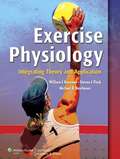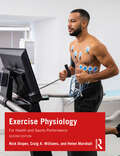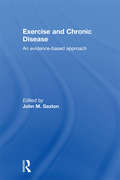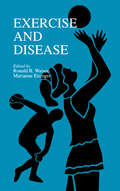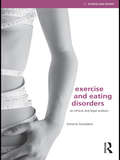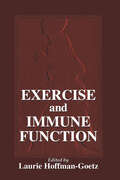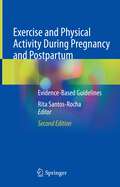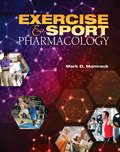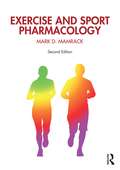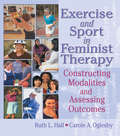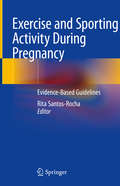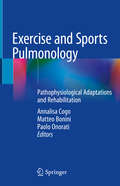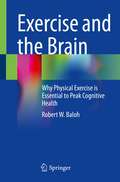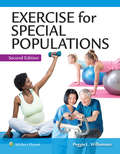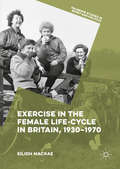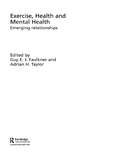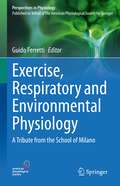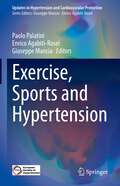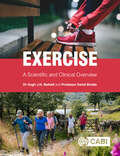- Table View
- List View
Exercise Physiology: Integrating Theory And Application
by William Kraemer Steven Fleck Michael DeschenesBuild the foundation of scientific knowledge and practical decision-making skills needed to excel in an exercise training career Master the core concepts of exercise physiology and learn how to apply them to the real-world challenges of exercise training with Exercise Physiology: Integrating Theory and Application, Third Edition. Designed to connect theory to practice, this engaging, accessible text gives students a thorough understanding of how the body adapts to exercise and environmental stresses and how basic physiology informs practical decisions. This new edition expands the coverage of practical applications, extends on our growing scientific knowledge of exercise physiology, explores the topic of “Exercise is Medicine”, and offers more guidance on finding reliable research-based answers to real-life questions. New content, as well as updated coverage of the endocrine system, applying research, nutritional support, and environmental effects make this the perfect resource to support the diverse case scenarios seen by personal trainers, strength coaches, fitness instructors, athletic trainers, and other exercise professionals.
Exercise Physiology: Integrating Theory and Application
by William J. Kraemer Steven J. Fleck Michael R. DeschenesDesigned for undergraduate course work, this exercise physiology textbook unites research and theory with real-world application so students can easily relate to the concepts being presented. The unique applied approach fully engages you in discovering how the human body works and responds to exercise. You’ll not only gain a solid foundation in exercise physiology concepts, you’ll also learn how to apply these concepts on the job to optimize athletic performance and well-being. Moreover, you’ll come to understand the vital health benefits of exercise and physical activity for all individuals at all ages, including special populations. <p><p> Beginning with basic exercise physiology concepts, the text progressively builds your knowledge by integrating these concepts into practical discussions of nutrition and training. The text stresses a research-based approach, enabling you to locate and evaluate the evidence you need to make good decisions. Numerous examples further underscore the importance of basic concepts and research in addressing real-life challenges in exercise and athletic training.
Exercise Physiology: Nutrition, Energy, and Human Performance
by Frank I. Katch Victor L. Katch William McArdleSelected as a Doody's Core Title for 2022! <P><P> Lippincott® Connect Featured Title Purchase of the new print edition of this Lippincott® Connect title includes access to the digital version of the book, plus related materials such as videos and multiple-choice Q&A and self-assessments. <P><P> Join the nearly half a million students who have built a solid foundation in the scientific principles underlying modern exercise physiology with this trusted, trendsetting text. Exercise Physiology: Nutrition, Energy, and Human Performance, 9th Edition, presents a research-centric approach in a vibrant, engaging design to make complex topics accessible and deliver a comprehensive understanding of how nutrition, energy transfer, and exercise training affect human performance. The extensively updated 9th Edition reflects the latest advances in the field as well as a rich contextual perspective to ensure readiness for today’s clinical challenges.
Exercise Physiology: for Health and Sports Performance
by Craig Williams Nick Draper Helen MarshallThis second edition of Exercise Physiology: For Health and Sports Performance brings together all the essential human anatomy and applied physiology that students of exercise science, physical education, and sports coaching will need to know.Written in a friendly, accessible style, and containing a wide range of features to help develop understanding, this book provides a complete one-stop shop for exercise physiology broken down into three fundamental parts: foundations of exercise physiology, applied exercise physiology, and the new Part 3, exercise prescription.With Parts 1 and 2 examining the theory, testing, and practical applications of exercise physiology, the new Part 3 reflects the changes in the field by increasing focus on physical activity and diverse populations and helps provides a more complete course text for any exercise physiology course at universities around the world.This newly revised book is key reading for undergraduate and postgraduate students in the fields of exercise physiology, sports performance, sports therapy, fitness and personal training, and other related sport science courses.
Exercise Physiology: for Health and Sports Performance
by Nick Draper Helen MarshallExercise Physiology for Health and Sports Performance brings together all the essential human anatomy and applied physiology that students of exercise science, physical education and sports coaching need to know. Written in a friendly, accessible style and containing a wide range of features to help develop understanding, this book provides a complete one-stop-shop for exercise physiology. The book is split into two key parts. Part One introduces the fundamental principles of nutrition, biochemistry, cell biology and the energy systems. Part Two builds on this foundation by applying the theory to exercise and sports performance in practice. With this innovative approach, the text enables you to become confident in your knowledge and understanding of energy generation and training principles for all sports. Including coverage of exercise in extreme environments and applications of physical activity for health, this will be the only exercise physiology textbook you will need!
Exercise and Chronic Disease: An Evidence-Based Approach
by John M. SaxtonIt is now widely accepted that there are important links between inactivity and lifestyle-related chronic diseases, and that exercise can bring tangible therapeutic benefits to people with long-term chronic conditions. Exercise and Chronic Disease: An Evidence-Based Approach offers the most up-to-date survey currently available of the scientific and clinical evidence underlying the effects of exercise in relation to functional outcomes, disease-specific health-related outcomes and quality of life in patients with chronic disease conditions. Drawing on data from randomized controlled trials and observational evidence, and written by a team of leading international researchers and medical and health practitioners, the book explores the evidence across a wide range of chronic diseases, including: cancer heart disease stroke diabetes parkinson's disease multiple sclerosis asthma. Each chapter addresses the frequency, intensity, duration and modality of exercise that might be employed as an intervention for each condition and, importantly, assesses the impact of exercise interventions in relation to outcomes that reflect tangible benefits to patients. No other book on this subject places the patient and the evidence directly at the heart of the study, and therefore this book will be essential reading for all exercise scientists, health scientists and medical professionals looking to develop their knowledge and professional practice.
Exercise and Diabetes
by Sheri R. ColbergPhysical movement has a positive effect on physical fitness, morbidity, and mortality in individuals with diabetes. Although exercise has long been considered a cornerstone of diabetes management, many health care providers fail to prescribe it. In addition, many fitness professionals may be unaware of the complexities of including physical activity in the management of diabetes. Giving patients or clients a full exercise prescription that take other chronic conditions commonly accompanying diabetes into account may be too time-consuming for or beyond the expertise of many health care and fitness professionals.The purpose of this book is to cover the recommended types and quantities of physical activities that can and should be undertaken by all individuals with any type of diabetes, along with precautions related to medication use and diabetes-related health complications. Medications used to control diabetes should augment lifestyle improvements like increased daily physical activity rather than replace them.Up until now, professional books with exercise information and prescriptions were not timely or interactive enough to easily provide busy professionals with access to the latest recommendations for each unique patient. However, simply instructing patients to "exercise more" is frequently not motivating or informative enough to get them regularly or safely active. This book is changing all that with its up-to-date and easy-to-prescribe exercise and physical activity recommendations and relevant case studies.Read and learn to quickly prescribe effective and appropriate exercise to everyone.
Exercise and Disease
by Marianne EisingerExercise and Disease reviews the role of exercise and physical fitness in the prevention or causation of cancer. Relevant mechanistic studies, particularly immunomodulation, are emphasized. The book also interprets effects of long-term exercise on immune functions and data that shows how exercise influences disease resistance. On the other hand, exercise may be involved in immune mediated motion injuries. Finally, exercise plays a potential role in cancer therapy. The book will be useful to researchers interested in the most recent developments and their interpretations.
Exercise and Eating Disorders: An Ethical and Legal Analysis (Ethics and Sport)
by Simona GiordanoEating disorders (EDs) have become a social epidemic in the developed world. This book addresses the close links between EDs and exercise, helping us to understand why people with EDs often exercise to excessive and potentially harmful levels. This is also the first book to examine this issue from an ethical and legal perspective, identifying the rights and responsibilities of people with EDs, their families and the fitness professionals and clinicians that work with them. The book offers an accessible account of EDs and closely examines the concept of addiction. Drawing on a wide range of medical, psychological, physiological, sociological and philosophical sources, the book examines the benefits and risks of exercise for the ED population, explores the links between EDs and other abuses of the body in the sports environment and addresses the issue of athletes with disordered eating behaviour. Importantly, the book also surveys current legislation and professional codes of conduct that guide the work of fitness professionals and clinicians in this area and presents a clear and thorough set of case histories and action points to help professionals better understand, and care for, their clients with EDs. Exercise and Eating Disorders is important reading for students of applied ethics, medical ethics and the ethics of sport, as well as for fitness professionals, psychiatrists, clinical psychologists, sports coaches and sport and exercise scientists looking to improve their understanding of this important issue.
Exercise and Immune Function (Nutrition in Exercise & Sport)
by Laurie Hoffman-GoetzIn Exercise And Immune Function, leading experts discuss what is known about physical activity and its effects on the immune system. This unique reference describes the science and application of exercise immunology, providing an excellent source of expert information for researchers, students, and practitioners. The impact of exercise on immune function in dieters, in combination with alcohol use, and in the elderly are addressed, and up-to-date reviews on the relationships between exercise and the risk of disease are provided. Anyone in basic medical science, sports medicine, exercise physiology, immunology, and health promotion should have a copy of this book.
Exercise and Physical Activity During Pregnancy and Postpartum: Evidence-Based Guidelines
by Rita Santos-RochaThis is the second edition of a well-received, practice oriented, multidisciplinary book filling the gap between evidence-based knowledge on the benefits of physical activity and exercise during pregnancy and postpartum and the implementation of exercise programs and related health promotion measures in pregnant women.Readers will find up-to-date evidence on the psychological, social, physiological, body composition, musculoskeletal, and biomechanical changes that occur during pregnancy and their implications for physical activity and exercise. Further, the authors equip the reader with the latest guidelines and detailed description of exercise testing, prescription, selection and adaptation for pregnant and postpartum women, including those with clinical conditions.This new edition has been thoroughly updated, and includes additional chapters focused on the pedagogical intervention in pre and postnatal exercise programs, exercise prescription and adaptation during postpartum and diet recommendations for the pregnant exerciser and athlete. Written by recognized experts in the field, the book aims to allay undue fears regarding the consequences of exercising during pregnancy. Moreover, it provides medical, sports, and fitness professionals both with the knowledge and the practical expertise needed to offer an optimal guidance on exercising to pregnant exercisers and athletes.
Exercise and Sport Pharmacology
by Mark D. MamrackExercise and Sport Pharmacology is an accessible book that will be useful for teaching upper-level undergraduates or entry-level graduate students about how drugs can affect exercise and as well as how exercise can affect the action of drugs. It leads students through the science-including the related pathology, exercise physiology, and drug action-to gain an understanding of these interactions. The book is divided into four parts. Part I provides the basics of exercise pharmacology, exercise physiology, and autonomic pharmacology; Part II presents chapters on the major cardiovascular and respiratory drug classes; Part III describes the frequently prescribed medications for such common conditions as diabetes, depression, pain, fever, inflammation, and obesity; and Part IV includes discussions of supplements and commonly used drugs such as caffeine, nicotine, cannabis, and performance-enhancing drugs. In Parts II through IV, the chapters include an overview of the pathology the drugs are designed to treat, how the drug works in the human body, the effect of exercise on how the body responds to a drug, and how exercise changes the fate of the drug in the body. Chapters also include information on the drug's possible health risks and whether taking the drug comes under scrutiny of sport-regulating agencies.Throughout, figures and tables help to illustrate and summarize content. Most chapters open with an on-going case example to apply and preview chapter content. In the text, boldface terms indicate for students which concepts can be found in the book's Glossary, for easy reference. Chapters conclude with a Key Concepts Review and Review Questions.
Exercise and Sport Pharmacology
by Mark D. MamrackExercise and Sport Pharmacology is an essential book for teaching upper-level undergraduates or entry-level graduate students about how drugs can affect exercise and how exercise can affect the action of drugs. It leads students through the related pathology, exercise physiology, and drug action of many of today's chronically used medications, and discusses how drugs can affect exercise performance. This new second edition of the book is divided into four parts: Section I provides the basics of pharmacology, exercise physiology, autonomic pharmacology, and the stress response; Section II presents chapters on major cardiovascular and respiratory drug classes; Section III describes frequently prescribed medications for such common conditions as diabetes, depression, pain, fever, inflammation, and obesity; and Section IV includes discussions of nutritional supplements and commonly used drugs such as caffeine, nicotine, cannabis, and performance-enhancing drugs. The second edition offers many updates, enhances muscle cell physiology, includes the involvement of the gut microbiome, and each chapter has a new section on the effects of aging. In Sections II and III, chapters include an overview of the pathology that therapeutic drugs are designed to treat and how the drug works in the human body. In contrast to standard pharmacology texts, Exercise and Sport Pharmacology also includes the effect of exercise on the pathology of the condition and the effect of exercise on how the body responds to a drug. Each chapter has a section on whether the drugs under discussion have performance-enhancing potential. Section IV is concerned with self-medication and drugs or supplements taken without a prescription or with limited medical supervision. Throughout, figures and tables as well as data from experiments in exercise pharmacology help to illustrate and summarize content. Each chapter opens with an on-going case example to preview and apply chapter content. In the text, boldface terms indicate which concepts are contained in the book's Glossary. Chapters conclude with a Key Concepts Review and Review Questions.
Exercise and Sport in Feminist Therapy: Constructing Modalities and Assessing Outcomes
by Ruth Hall Carole OglesbyIntegrate physical activity into feminist therapy!This book explores the healing use of exercise and sport as a helpful adjunct to therapy from several therapeutic orientations within the feminist context. It looks at the ways that feminist orientations challenge the mind-body dichotomy and explores the benefits of integrating physical activity, exercise, and sport into therapy. From the editors: "The contributors to this book display a diversity of theory and research approaches, including the integration of the exercise/sport sciences and exercise physiology. This volume is unique in that there has been comparatively little written about the use of exercise in therapy even though exercise is a wonderful and useful intervention tool in the treatment of depression, stress, anxiety disorders, and chronic pain. This book illustrates how exercise can be applied to inpatient and outpatient populations, to the neurotic, and to the chronically mentally ill. Exercise can reduce the incidence of chronic diseases, including diabetes and hypertension, as well as address physical problems such as obesity. Exercise can give one a sense of mastery and self-confidence. As our authors suggest, exercise must be tailored to specific issues and client populations and diagnoses, level of functioning, age, overall health, and cultural context must all be taken into account."Exercise and Sport in Feminist Therapy: Constructing Modalities and Assessing Outcomes examines: the theory supporting the use of physicality to enhance various types of psychotherapy-psychoanalytic, cognitive-behavioral, constructivist, narrative, and organismic/systems practical methods of integrating exercise into varied orientations an exercise program for women with fibromyalgia a way to use exercise to enhance rehabilitation from breast cancer the use of exercise in group therapy for women suffering with chronic mental illness the “tend and befriend” model, which can help clients to meet their exercise program responsibilities
Exercise and Sporting Activity During Pregnancy: Evidence-Based Guidelines
by Rita Santos-Rocha<p>This clinically and practice oriented, multidisciplinary book is intended to fill the gap between evidence-based knowledge on the benefits of physical activity and exercise during pregnancy and the implementation of exercise programmes and related health promotion measures in pregnant women. It will provide medical, sports, and fitness professionals both with the knowledge needed to allay undue fears regarding the consequences of exercising during pregnancy and with the practical expertise to offer optimal guidance on exercising to pregnant exercisers and athletes. <p>Readers will find up-to-date evidence on the psychological, social, physiological, body composition, musculoskeletal, and biomechanical changes that occur during pregnancy and their implications for physical activity and exercise. Detailed descriptions are provided of the components of exercise testing and prescription for pregnant women, the current evidence-based and practice-oriented guidelines, and exercise selection and adaptation during pregnancy. Exercises specifically targeting musculoskeletal health are discussed separately, and a concluding chapter explains the nutritional requirements in pregnant women who exercise.</p>
Exercise and Sports Pulmonology: Pathophysiological Adaptations and Rehabilitation
by Annalisa Cogo Matteo Bonini Paolo OnoratiThis book provides an innovative and comprehensive overview of the relationship between lung and exercise, both in healthy, active subjects and in subjects with chronic respiratory diseases. It investigates in detail the central role of the lungs during exercise and illustrates the impact of respiratory impairment due to both acute and chronic lung diseases on performance. Further, the book presents the latest evidence-based findings, which confirm that exercise is an effective and safe form of prevention and rehabilitation in respiratory diseases.The first section describes the changes in the respiratory system during exercise and the contribution of respiration to exercise, while readers will learn how to perform a respiratory assessment in the second section. The third section addresses a broad range of chronic respiratory diseases and the (in)ability of those affected to play sports and perform exercise, thus providing a basis for individual assessments. The last two sections focus on respiratory training, rehabilitation and the relationship between respiration and the environment, e.g. in high-altitude and underwater sports. The book will appeal to a wide readership, including pulmonologists, sport medicine physicians, physiotherapists and trainers, as well as instructors and students in exercise science.
Exercise and Well-Being after High-Performance Sport: Post-Retirement Perspectives
by Luke Jones, Zoë Avner, and Jim DenisonExercise and Well-Being after High-Performance Sport explores whether high-performance athletes have healthy and prosperous relationships with exercise and wellbeing after retirement from elite sports. This edited collection is the first of its kind to bring together sociologically informed accounts from former high-performance athletes about their retirement experiences and post-sporting careers. The chapters combine creative narrative writing and social theory to frame the experiences of exercise and wellbeing after retirement from high-performance sport. Written by former high-performance athletes who are now socio-cultural sports’ scholars, the authors explore how retiring from elite sport impacted their relationship to exercise and physical activity, identity, and long-term mental health. This book is key reading for graduate and postgraduate students, as well as academics and researchers interested in sports retirement experiences, sport sociology, mental health, and wellbeing.
Exercise and the Brain: Why Physical Exercise is Essential to Peak Cognitive Health
by Robert W. BalohThis book focuses on the benefits of exercise for prevention and treatment of chronic brain disorders. It is a guide for finding the right exercise routine for each individual. The goal is to show the reader why everyone needs to exercise, especially as we get older. The brain needs physical exercise both for normal health and for preventing and treating diseases common with aging.How much exercise is needed? As we see throughout the book there is no one fits all rule with regard to the amount of exercise required. The key is to make exercise a part of one’s daily routine. The beneficial effect of exercise is transient, lasting days to weeks, so it must be a lifelong pursuit. Can we exercise too much? Anything done in excess can potentially be dangerous but with the common sense approach outlined in this book anyone, regardless of underlying health condition, can find some type of exercise that is safe and effective.
Exercise for Special Populations
by Peggie WilliamsonPublisher's Note: Products purchased from 3rd Party sellers are not guaranteed by the Publisher for quality, authenticity, or access to any online entitlements included with the product. This updated 2nd Edition of Williamson’s highly applied Exercise for Special Populations provides just enough background for practicing and future personal trainers, exercise physiologists, and other health and fitness professionals to develop and implement exercise programs for special populations. For each condition, the book provides a general description, anatomy and physiology variances, precautions, recommendations for exercise testing and prescription, instructions and images of various exercises, and nutritional considerations. Reflecting the latest best practices in the field, the 2nd Edition features new chapters and pedagogy and a powerful suite of online resources.
Exercise in the Female Life-Cycle in Britain, 1930-1970
by Eilidh MacraeThis book examines how adolescence, menstruation and pregnancy were experienced or 'managed' by active women in Britain between 1930 and 1970, and how their athletic life-styles interacted with their working lives, marriage and motherhood. It explores the gendered barriers which have influenced women's sporting experiences. Women's lives have always been shaped by the socially and physically constructed life-cycle, and this is all the more apparent when we look at female exercise. Even self-proclaimed 'sporty' women have had to negotiate obstacles at various stages of their lives to try and maintain their athletic identity. So how did women overcome these obstacles to gain access to exercise in a time when the sportswoman was not an image society was wholly comfortable with? Oral history testimony and extensive archival research show how the physically and socially constructed female life-cycle shaped women's experiences of exercise and sport throughout these decades.
Exercise, Autophagy and Chronic Diseases
by Ning ChenThis book establishes a bridge between exercise-mediated functional status of autophagy and non-communicable chronic diseases for elucidating and clarifying the corresponding signal pathways and underlying mechanisms. The book consists of 13 chapters focusing on the in-depth discussion on signal pathways for regulating the functional status of autophagy for the prevention, treatment and rehabilitation of chronic diseases, the optimization of exercise intervention strategies for common and frequently-occurring chronic diseases, and the development of exercise mimetic pills for the persons with disability for exercise performance, or the persons without willing to exercise. This book is interesting and will be useful to a wide readership in the various fields of exercise science, exercise fitness, sports medicine, preventive medicine, and functional foods.
Exercise, Health and Mental Health: Emerging Relationships
by Guy E.J. Faulkner Adrian H. TaylorExercise, Health and Mental Health provides an introduction to this emerging field and a platform for future research and practice. Written by internationally acclaimed exercise, health and medical scientists, it is the first systematic review of the evidence for the potential role of exercise in: treating and managing mental health problems including dementia, schizophrenia, drug and alcohol dependence coping with chronic clinical conditions including cancer, heart disease and HIV/AIDS enhancing well-being in the general population – by improving sleep, assisting in smoking cessation, and as a way of addressing broader social issues such as anti-social behaviour. Adopting a consistent and accessible format, the research findings for each topic are clearly summarized and critically examined for their implications.
Exercise, Respiratory and Environmental Physiology: A Tribute from the School of Milano (Perspectives in Physiology)
by Guido FerrettiThis book sheds new light on the history of exercise physiology and how it essentially grew, thanks to the work of a few major Schools. Analysing and interpreting the evolution of the field, the authors focus on the School of Milano, which was founded by Rodolfo Margaria and is one of the most prominent representatives, having played a central role in promoting and advancing this field of physiology. In turn, the authors trace Margaria’s biography; under his influence, the school introduced new concepts with regard to both the energetics of muscular exercise and to human locomotion. These concepts were further developed by Margaria’s pupils and by subsequent generations. Indeed, the course that was set in Milano greatly influenced the entire history of modern physiology. Readers with a keen interest in the origins of modern concepts and technologies in exercise physiology will find this book a fascinating and informative read.
Exercise, Sports and Hypertension (Updates in Hypertension and Cardiovascular Protection)
by Giuseppe Mancia Enrico Agabiti-Rosei Paolo PalatiniThis book presents the current knowledge on the mechanisms by which exercise lowers blood pressure in hypertension and on its effects on the heart and arteries. In addition, it focuses on the optimal exercise protocols, the international consensus on clinical implementation, and the clinical indications for special populations (obese, diabetic etc). It also addresses possible drawbacks of exercise on left ventricular structure and function. Many experts in epidemiology, patophysiology and clinical research have contributed in preparing the chapters, with the main purpose of guiding clinicians in the optimal application of the present knowledge and to stimulate scientists to fill the gaps in knowledge by performing further research.The book is addressed not only to specialists in Hypertension, Internal Medicine, Cardiology, Metabolism, and Nephrology, but also to general practitioners and all healthcare professionals working in the field of rehabilitation medicine.
Exercise: A Scientific and Clinical Overview
by Dr Hugh J. Bethell Professor David BrodieThis book is about exercise - what it is, how it affects the individual, how it is measured and most of all what benefits it brings. Beginning with an introduction to the history and biology of exercise, the authors review the interactions between exercise and specific diseases, such as diabetes, coronary heart disease, cancer and many more, before considering exercise in a wider health context. The book covers: - Current societal norms, as well as the social and economic costs of inactivity. - Exercise for life - from starting young, to pregnancy, longevity and frailty. - Complications of exercise. - The intersections of behavioural psychology and exercise, such as encouragement and excuse making. With comprehensive and clear explanations based on sound science, yet written in an approachable and accessible style, this book is a valuable resource for students of medicine, public health, physiotherapy, sports science, coaching and training.

